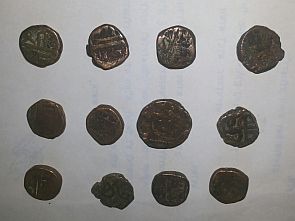 | « Back to article | Print this article |
 Driver hands it over to members of the the local panchayat who now wait for the Archaeological Survey of India ASI to take custody. Rachna Parmar reports.
Driver hands it over to members of the the local panchayat who now wait for the Archaeological Survey of India ASI to take custody. Rachna Parmar reports.
An auto rickshaw driver found around 20 ancient gold and brass coins while he was waiting for passengers near the historic Shitladevi temple off the Kelwa coast in Thane, on Monday afternoon.
The coins, which the locals claim date back to the 14th century AD, have some unique stampings on it and are now in the custody of the Kelwe gram panchayat officials.
On Monday afternoon, Bhupesh Jadhav, 43, had parked his three-wheeler near the temple. As he walked to the temple’s water stand to get a drink, he saw something glittering in the sand.
“I was curious, so I started digging, and to my astonishment, I found around 20 coins bearing some markings on them,” said Jadhav.
This was the same spot where in 2004, some officials of the Archaeological Survey of India had come in search for artifacts near the temple, but had returned empty-handed.
“Perhaps, they had come in search of the same coins, which were now spotted by Jadhav,” said Ashish Patil, a Kelwe resident.
A huge crowd of locals had gathered at the spot. Soon, word spread, and attracted some members of the Kelwe gram panchayat who arrived at the spot and Jadhav handed the coins to them.
“We have informed the ASI, Mumbai, who would be visiting the spot this weekend,” said a gram panchayat member. Patil, who is also a history lover and an archaeology enthusiast, claims that the coins date back to the 14th century AD.
“Some 800 years ago, the Kelwe area was ruled by Raja Bhoj who had built the Asherigadh Fort near the Kelwe beach. Asheri is the ‘big brother’ of other forts in the Palghar region because of its height. At the beginning of 14th century, Raja Bimb, the ruler of Mahim, captured it from the Kolis. The Portuguese had control of the fort in 1556 and made it the head of 38 villages. The fort was then taken by the Mughals in the mid-17th century, but was again captured by the Portuguese in 1683.
“In the battle between Mahim and Vasai in 1737, Chimanji Appa (the younger brother of Bajirao Peshwa of the Maratha Empire) took over the control of the fort and it was under the rule of Marathas till 1818. Then it was handed over to the British. From Kelwe beach, one can see forts such as Asheri, Adasul, Kohoj,” said Patil.
“The ASI would give its final take on the coin findings, and we locals are olooking forward to it,” said Patil.